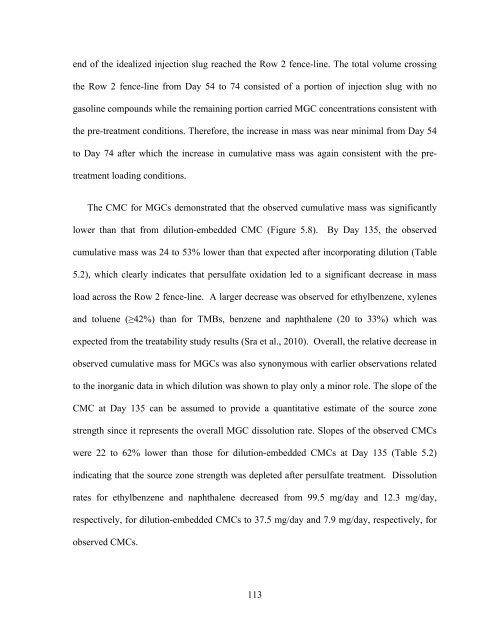Time (days) - UWSpace - University of Waterloo
Time (days) - UWSpace - University of Waterloo
Time (days) - UWSpace - University of Waterloo
Create successful ePaper yourself
Turn your PDF publications into a flip-book with our unique Google optimized e-Paper software.
end <strong>of</strong> the idealized injection slug reached the Row 2 fence-line. The total volume crossing<br />
the Row 2 fence-line from Day 54 to 74 consisted <strong>of</strong> a portion <strong>of</strong> injection slug with no<br />
gasoline compounds while the remaining portion carried MGC concentrations consistent with<br />
the pre-treatment conditions. Therefore, the increase in mass was near minimal from Day 54<br />
to Day 74 after which the increase in cumulative mass was again consistent with the pre-<br />
treatment loading conditions.<br />
The CMC for MGCs demonstrated that the observed cumulative mass was significantly<br />
lower than that from dilution-embedded CMC (Figure 5.8). By Day 135, the observed<br />
cumulative mass was 24 to 53% lower than that expected after incorporating dilution (Table<br />
5.2), which clearly indicates that persulfate oxidation led to a significant decrease in mass<br />
load across the Row 2 fence-line. A larger decrease was observed for ethylbenzene, xylenes<br />
and toluene (≥42%) than for TMBs, benzene and naphthalene (20 to 33%) which was<br />
expected from the treatability study results (Sra et al., 2010). Overall, the relative decrease in<br />
observed cumulative mass for MGCs was also synonymous with earlier observations related<br />
to the inorganic data in which dilution was shown to play only a minor role. The slope <strong>of</strong> the<br />
CMC at Day 135 can be assumed to provide a quantitative estimate <strong>of</strong> the source zone<br />
strength since it represents the overall MGC dissolution rate. Slopes <strong>of</strong> the observed CMCs<br />
were 22 to 62% lower than those for dilution-embedded CMCs at Day 135 (Table 5.2)<br />
indicating that the source zone strength was depleted after persulfate treatment. Dissolution<br />
rates for ethylbenzene and naphthalene decreased from 99.5 mg/day and 12.3 mg/day,<br />
respectively, for dilution-embedded CMCs to 37.5 mg/day and 7.9 mg/day, respectively, for<br />
observed CMCs.<br />
113

















